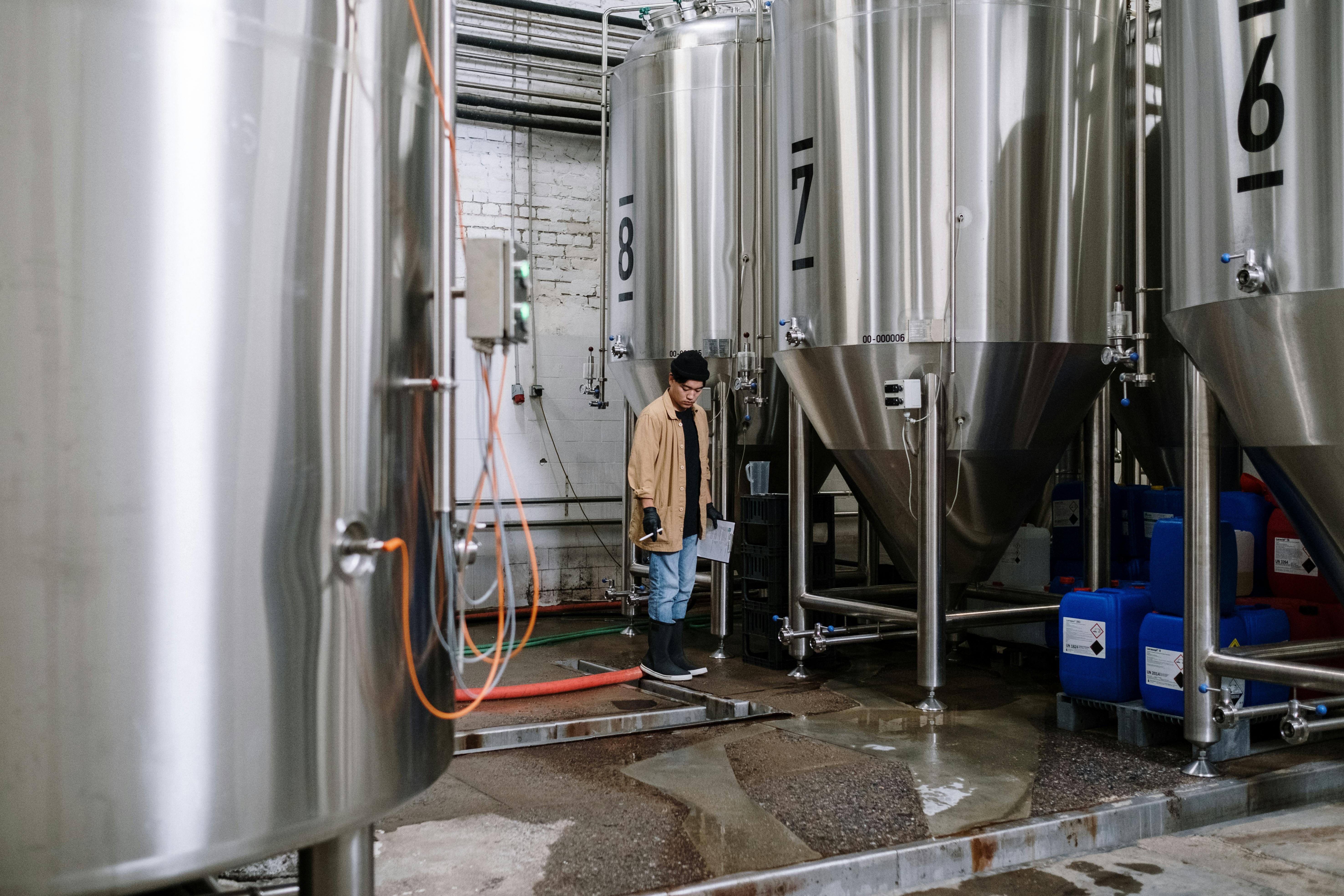Distillation and fermentation are two processes used to purify liquids. Distillation involves boiling a liquid and then condensing the steam back into liquid form, while fermentation is a chemical process that involves the breakdown of sugars into alcohol or acids. Both are used to create products such as beer, wine, and distilled spirits like vodka and whiskey. While both processes help to purify liquids, they are fundamentally different in terms of how they function.Distillation is a process that involves heating a liquid mixture to separate the components by boiling point. During the process, vapor is produced and then cooled, condensed, and collected. Distillation is used to purify liquids and separate mixtures of liquids with different boiling points.
Fermentation
Fermentation is a metabolic process that converts sugar to acids, gases, or alcohol. It occurs in many organisms, including yeast and bacteria, and is also used in the production of foods such as beer, wine, cheese, yogurt, bread, and pickles. During fermentation, sugars are broken down into simpler molecules such as ethanol or lactic acid. These molecules are then used as energy sources for the organism or can be converted into other products. Fermentation can be used to create a wide range of products including breads, cheeses, wines, beers and spirits. The process has been used since ancient times to preserve food and make it more palatable. In addition to its role in food production, fermentation has also been used for medical purposes such as the production of antibiotics and other drugs. Fermentation is an important process in the production of many products and has a variety of applications in industry and medicine.
Similarities Between Distillation and Fermentation
Distillation and fermentation are two processes that are widely used in the food and beverage industry. Both processes involve the use of heat to separate components of a liquid mixture, but they differ in the end product they produce. Despite their differences, there are some similarities between distillation and fermentation.
The most obvious similarity between distillation and fermentation is that they both involve the use of heat to separate components of a liquid mixture. This is done by boiling the mixture and then condensing the vaporized material into a separate container. This process allows for the separation of useful components from the original liquid mixture, such as alcohol or essential oils.
Another similarity between distillation and fermentation is that both processes can be used to create alcoholic beverages. In distillation, alcohol can be separated from other compounds in a liquid mixture by boiling it and then condensing it into a separate container. In fermentation, sugars are converted into alcohol using yeast or other microorganisms.
Finally, both processes can be used to create products with unique flavor profiles. Distillation can be used
Differences Between Distillation and Fermentation
Distillation and fermentation are two processes used for the production of various products and they have some similarities, but also some distinct differences. Distillation is a process of separating liquid mixtures into their individual components by heating them to different temperatures. The mixture is heated until it boils, the vapors produced are then condensed back into a liquid, which is then collected in a separate container. Fermentation, on the other hand, is the process of converting sugars present in the raw material into alcohols using yeast or bacteria.
One of the main differences between distillation and fermentation is that distillation requires an external source of heat to separate liquids while fermentation does not require any additional energy input other than that provided by the natural environment. Another key difference is that distilling separates pure substances from mixtures while fermentation produces new compounds from existing ones. Distilling can also be used to purify certain liquids or extract certain substances from them, while fermentation can be used to produce alcoholic beverages as well as food products such as cheese and yogurt.
A further difference between distillation and fermentation lies in the
Distillation Process
Distillation is a process used to separate components or substances from a liquid mixture by using selective boiling and condensation. Distillation is one of the oldest known methods of purifying liquids and has been used for thousands of years to produce alcoholic beverages, essential oils, and other products. The process of distillation involves boiling a liquid mixture in order to vaporize the more volatile components, which are then cooled and condensed back into liquid form. The components that have been vaporized are collected in a separate container, leaving behind the less volatile components in the original container. This process can be repeated multiple times in order to further purify the desired component. In addition to separating different components from a liquid mixture, distillation can also be used to purify water by removing impurities such as salts and heavy metals.
The distillation process begins with heating the mixture to its boiling point. As it is boiled, the more volatile components will evaporate first due to their lower boiling points. These vapors will then be directed into a condenser which cools them back into liquid form. This condensed liquid is then collected in a separate container while the remaining liquid

Process of Fermentation
Fermentation is a process in which sugars in a food are converted into acids, gases, or alcohol. In the context of food production, it typically refers to the conversion of carbohydrates to alcohol or organic acids using yeasts, bacteria, or a combination thereof. The most common types of fermentation are alcoholic fermentation and lactic acid fermentation. Other types of fermentation include acetic acid fermentation and butyric acid fermentation. Fermentation has been used for centuries to produce alcoholic beverages such as beer and wine. It is also used to preserve foods such as sauerkraut, pickles, kimchi, and yogurt.
Alcoholic fermentation is the process in which yeast converts sugar into ethanol and carbon dioxide. This type of fermentation is commonly used to produce beer, wine, and other alcoholic beverages. Lactic acid fermentation is the process in which bacteria convert sugars into lactic acid. This type of fermentation is commonly used to produce yogurt, cheese, and other fermented dairy products. Acetic acid fermentation is the process in which bacteria convert ethanol into acetic acid (vinegar). Butyric acid fermentation is
Distillation
Distillation is a process of separating components from a liquid mixture through the process of evaporation and condensation. It is one of the oldest and most widely used methods of purification in chemical industries. Distillation is used to purify water, separate impurities from liquids, and to separate different types of liquids with different boiling points. It can also be used to produce essential oils and other products.
Uses of Distillation
Distillation has a variety of uses in many industries. It is used to produce distilled alcoholic beverages like vodka, whiskey, and brandy, as well as purified drinking water. In the food industry, it is used to make essential oils for flavorings, perfumes, and food ingredients such as vanillin or menthol. In the medical industry, distillates are often used to sterilize equipment or produce sterile solutions for medicinal use. Distillates are also used in the production of industrial chemicals like hydrochloric acid and ethylene glycol.
In addition to being used in industry, distillation can also be used at home for practical purposes such as purifying water
Uses of Fermentation
Fermentation is an ancient process that has been used for centuries to preserve foods, create various flavors and textures, and even to produce alcohol. It is a natural process that occurs when bacteria or yeast break down carbohydrates in the food, releasing compounds such as lactic acid or ethanol. This process can be used to make a wide variety of products, from bread and cheese to beer and wine.
One of the most common uses of fermentation is in the production of alcoholic beverages. Fermentation produces ethanol, which is then consumed as alcohol. Beer, wine, and spirits such as whisky and vodka all rely on fermentation to produce their distinct flavors and aromas. The process also helps preserve the alcohol for longer periods of time by decreasing oxygen levels in the beverage.
Fermentation is also used to produce non-alcoholic drinks like kombucha, kefir, and yogurt drinks. These drinks are made with cultures of beneficial bacteria which help break down carbohydrates in the food, creating a unique flavor profile with probiotic benefits. In addition to these health benefits, these drinks are also low-calorie

Conclusion
Distillation and fermentation are two processes that are used to separate and extract chemicals from liquids. Both processes involve heating a liquid to its boiling point, but the difference between them is that distillation captures the volatile compounds while fermentation captures the non-volatile compounds. Distillation is often used to purify liquids, while fermentation is used to produce alcohols and other products from carbohydrates. Both processes can be used in combination with each other, depending on the desired outcome. Ultimately, it depends on the situation which process would be more suitable for achieving the desired result.
In conclusion, distillation and fermentation both involve heating a liquid to its boiling point, but their main difference lies in what they are extracting from the liquid. Distillation is used for purification while fermentation can be used for producing alcohols and other products from carbohydrates. Depending on the desired outcome, either process or a combination of both may be necessary.

